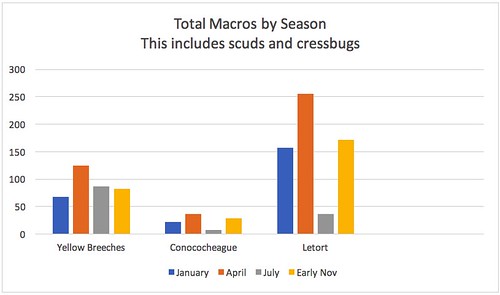The chart below includes the total number of all macroinvertebrates in seine. The July sample in Letort may have been impacted by dense weeds producing a reduced number.
This survey sought to identify macroinvertebrate populations in three different central PA stream types over the course of a year for the purpose of shedding light on nymph populations that might be of interest to fly fishermen. Three streams were chosen reflecting a freestone stream (Conococheague), a semi-limestoner (Yellow Breeches), and a limestoner (Letort).
I attempted to ensure that each kick seine survey was done in as close to the exact spot in the riffle each time I conducted the survey. These surveys were done in January, April, July, and early November. Although I don’t claim that this effort was entirely scientific, the results do shed some light on nymph numbers and characteristics. Moreover, the results bear out fly fishing conventional wisdom: that nymphs are more numerous and larger in springtime. In all three streams, the macro biomass was highest in April. The graph above reveals the fluctuation in the riffle by season. Of note, the Letort far exceeded the other streams in total biomass, although as one would expect, this difference was largely due to scuds and cress bugs. If one were to break out scuds and cress bugs from Letort, the number of nymphs would have been less than Conococheague. If you’re a limestone stream nympher, Letort in particular, scud and cress bug patterns are well known for a reason.
Among general observations of the streams’ combined results that I think merit note are a couple things:
1. The relative scarcity of stoneflies and caddis compared to the much more numerous mayflies.
2. The generally small size of these nymphs throughout the seasons, but especially in summer and fall. Most of these bugs averaged only about a quarter of an inch or less in body length (not counting tails) and would be imitated on hooks around #18 or less. Only the rare stoneflies and a few of the largest march browns would match a #14 nymph hook.
For comparison, the images below show the relative difference in size of nymphs in Yellow Breeches in April (upper image) and late November (lower image).
For more detailed information with bug numbers broken out by species and discussion, please feel free to check out the discussion in the Hatch and Entomology forum here.


This survey sought to identify macroinvertebrate populations in three different central PA stream types over the course of a year for the purpose of shedding light on nymph populations that might be of interest to fly fishermen. Three streams were chosen reflecting a freestone stream (Conococheague), a semi-limestoner (Yellow Breeches), and a limestoner (Letort).
I attempted to ensure that each kick seine survey was done in as close to the exact spot in the riffle each time I conducted the survey. These surveys were done in January, April, July, and early November. Although I don’t claim that this effort was entirely scientific, the results do shed some light on nymph numbers and characteristics. Moreover, the results bear out fly fishing conventional wisdom: that nymphs are more numerous and larger in springtime. In all three streams, the macro biomass was highest in April. The graph above reveals the fluctuation in the riffle by season. Of note, the Letort far exceeded the other streams in total biomass, although as one would expect, this difference was largely due to scuds and cress bugs. If one were to break out scuds and cress bugs from Letort, the number of nymphs would have been less than Conococheague. If you’re a limestone stream nympher, Letort in particular, scud and cress bug patterns are well known for a reason.
Among general observations of the streams’ combined results that I think merit note are a couple things:
1. The relative scarcity of stoneflies and caddis compared to the much more numerous mayflies.
2. The generally small size of these nymphs throughout the seasons, but especially in summer and fall. Most of these bugs averaged only about a quarter of an inch or less in body length (not counting tails) and would be imitated on hooks around #18 or less. Only the rare stoneflies and a few of the largest march browns would match a #14 nymph hook.
For comparison, the images below show the relative difference in size of nymphs in Yellow Breeches in April (upper image) and late November (lower image).
For more detailed information with bug numbers broken out by species and discussion, please feel free to check out the discussion in the Hatch and Entomology forum here.






